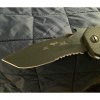serrations may have its uses.
but im pretty sure for many,
the problem lies with the lack
of knowlege or necessary tools
to keep them in tip top condition.
mind you, its even a task for
a great number of folks to be able to
keep a fine edge on their plain edges...
i agree completely that a short bladed
combo edge folder will see the
placement of its serrations
get in the way of task requiring
one to choke up the blade for
finer controlled cutting.
i guess serrations would be fine
if such a cutting method
doesn't come up at all
as an every day occurance....
but im pretty sure for many,
the problem lies with the lack
of knowlege or necessary tools
to keep them in tip top condition.
mind you, its even a task for
a great number of folks to be able to
keep a fine edge on their plain edges...
i agree completely that a short bladed
combo edge folder will see the
placement of its serrations
get in the way of task requiring
one to choke up the blade for
finer controlled cutting.
i guess serrations would be fine
if such a cutting method
doesn't come up at all
as an every day occurance....





